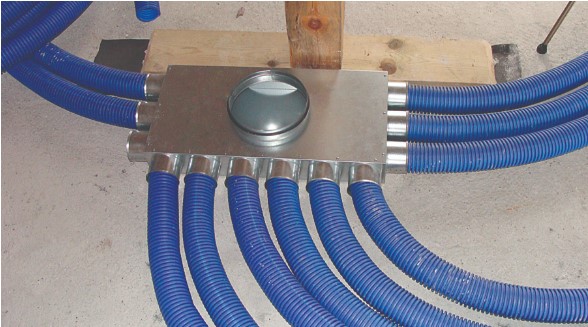Flexible Ducts for Heat Recovery Systems

What are flexible ducts?
Flexible air ducts are the modern standard for air distribution in residential heat recovery systems. Unlike traditional metal boxes, a separate, small-diameter polymer (HDPE) pipe is run from a central hub (manifold) to each room. This technology (also known as a radial or 'star' system) ensures high airtightness, hygiene, and simplicity of concealed installation.
Why is Ductwork Quality Critically Important?
The efficiency of an expensive heat recovery unit and its compliance with EU (ErP) and local building codes depend directly on the quality of the ductwork system. Here are the key requirements that a modern system must meet:
- Airtightness and ErP Compliance: Leaky ducts (Class A or B) lead to air loss, forcing the fan to work overtime and consume 50-150% more energy. This increases the SFP (Specific Fan Power) value, causing the entire system to fail compliance with the mandatory ErP directive. Quality systems with original gaskets achieve Airtightness Class C (EN 12237), which guarantees low energy consumption and compliance with regulations.
- Hygiene and Air Quality: A smooth inner surface with an antibacterial and antistatic coating complies with the strict principles of the German VDI 6022 standard (a European benchmark for ventilation cleanliness) keeping the system clean and the air healthy.
- Acoustic Comfort: Ventilation noise is caused by high air velocity and turbulence. A system with a dedicated duct to each room allows for a low flow velocity, which helps to meet strict local building codes for noise levels in living spaces and eliminates cross-talk noise.
- Long-Term Savings: Saving on the initial cost (capital expenditure) of cheap, leaky ducts results in significantly higher bills for electricity (operating expenses) over the building's lifespan. A high-quality, airtight system is a smart investment that quickly pays for itself.
Design and Installation Principles
- Individual Ducts: The system is built around a central distribution box (manifold), from which a separate, continuous length of pipe runs to each room (a layout also known as a radial or 'star' system). This eliminates the transfer of noise and odors between rooms.
- Concealed and Compact Installation: Thanks to their flexibility and small diameter (75-90 mm), the pipes are easily installed in floor screeds, ceiling structures, or walls, taking up minimal space.
- Minimum Connections, Maximum Reliability: The pipe is supplied in coils (usually 50 m), allowing for continuous runs from the manifold to the room, avoiding extra connections that are potential points of leakage.
- Flow Rate Scaling: For rooms with a larger area or higher air exchange requirements (e.g., kitchen-living rooms), two or three parallel ducts are run to a single diffuser, combining their airflow capacity.
- Airtight Connections: Class C airtightness is achieved only by using original gaskets at the connection points between the pipes, manifolds, and plenum boxes.
Comparison with Traditional Galvanized Steel Systems
| Characteristic |
Flexible Systems with Individual Ducts |
Traditional Galvanized Steel Systems |
| Airtightness |
High (Class C/D). Guaranteed by minimal connections and factory-made seals. |
Depends on the installer. Numerous joints and seams present a high risk of leaks and efficiency loss. |
| Installation Speed |
High. The pipe is easily bent and installed in continuous sections. |
Low. Requires cutting, fitting, and sealing of many straight sections and fittings. |
| Hygiene |
High. A smooth, antistatic inner surface prevents dust accumulation. |
Medium. Folded seams and stiffeners can become places where dirt accumulates. |
| Acoustics |
High. No "cross-talk" noise between rooms. |
Low. Noise and conversations can be transmitted between rooms through a common main duct. |
| Design Flexibility |
High. Easy to route around obstacles and install in limited spaces (e.g., in an 8-9 cm screed). |
Low. Requires a large number of fittings (elbows, transitions) and more space for installation. |
What to Look for When Buying
In summary, when choosing a flexible duct system for heat recovery, it's important to pay attention to four key aspects:
- Airtightness: Ensure the system (pipes and connections) can achieve at least Class C to comply with ErP regulations.
- Hygiene: Prefer pipes with a smooth inner surface and antibacterial/antistatic coatings.
- Strength and Durability: For concealed installation, especially in concrete, choose ducts with proven high compressive strength.
- System Integrity: Remember that the desired result is achieved only through the integrated use of compatible elements: pipes, seals, manifolds, and plenum boxes.
Professional System Installation
Correctly selecting components is only half the battle. Our engineers and in-house installation teams will ensure the design and professional installation of the entire ductwork system to guarantee its airtightness, efficiency, and quiet operation.
Examples of Systems and Components

CE Certification and ErP Compliance
All ventilation units and system components supplied by Akvilon are CE marked, confirming their full compliance with EU regulations, including the Ecodesign (ErP) Directive. This is your guarantee of the equipment's safety, efficiency, and legality.
Need Help with System Components?
Our engineers are ready to help you calculate and select all the components for your flexible ductwork system. You can also purchase all necessary components in our online shop.
|